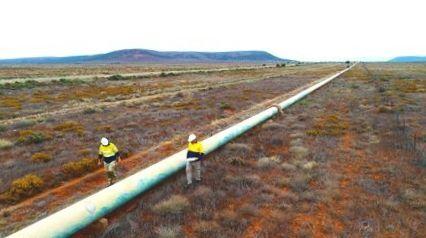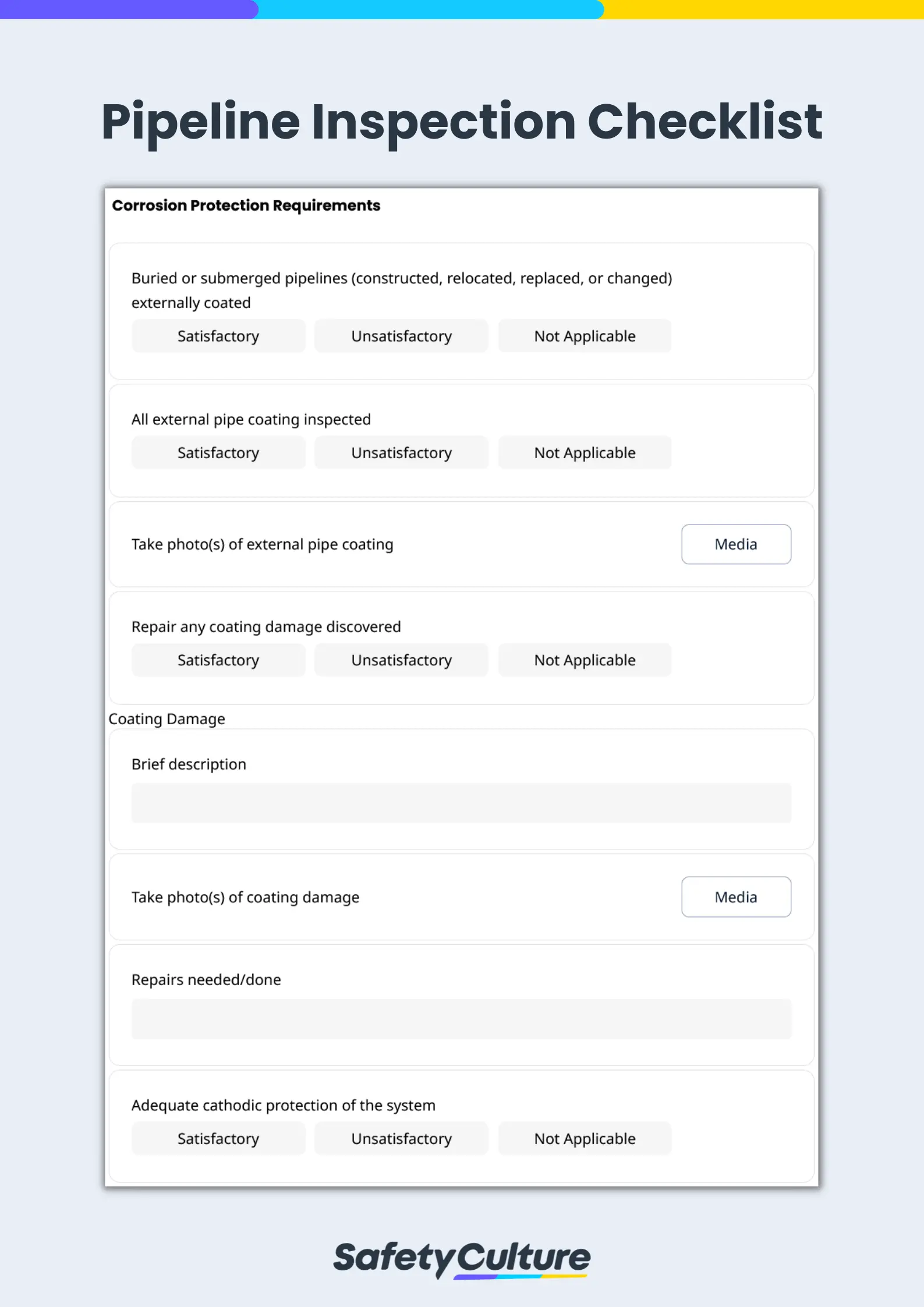What is a Pipeline Inspection?
A pipeline inspection is conducted by pipeline engineers as part of overall preventive maintenance to verify the integrity of a pipeline system and reduce the risks of leaks, pressure surges, and corrosion. Pipeline operators should empower frontline workers to perform routine pipeline inspections with mobile-ready tools for triggered alerts to the right people when potential issues arise.
What is a Pipeline Corrosion Inspection Report?
A pipeline corrosion inspection report is a comprehensive document used by area managers to anticipate corrosion-related problems and mitigate their consequences, such as disruptions in power, transportation, and infrastructure. Automatically generating and submitting pipeline corrosion inspection reports helps site supervisors control corrosion immediately and minimize costs.
What Should be Included in a Pipeline Inspection Report?
A pipeline inspection checklist can vary according to the specifications of a project, team, or business. The following items, however, should ideally be included during pipeline inspections to ensure a well-maintained pipeline system:
- Procedures
- Corrosion Control
- Atmospheric Corrosion Control
- Coating
- Cathodic Protection
- Test Stations
- Remedial Measures
- Monitoring
The Pipeline Inspection Four-step Process
In a report filed by Energy Transfer Partners with the Pipeline and Hazardous Materials Safety Administration last July, corrosion ruptured a 30-inch diameter steel pipe near Missouri Highway 15. The pipeline eventually exploded and incurred a total incident cost of $1.4 million. Global pipeline operators can prevent similar incidents from occurring through corrosion risk management and following the pipeline external corrosion direct assessment methodology developed by the National Association of Corrosion Engineers (NACE International) below:
-
Step 1: Pre-assessment
Pipeline operators should collect historic and current data such as construction records, operation and maintenance histories, and corrosion control procedures to analyze which indirect inspection tools should be used. Select indirect inspection tools such as close-interval survey (CIS), current voltage gradient (ACDVG/DCVG) survey, and/or AC current attenuation survey based on the ability to detect corrosion activity.
-
Step 2: Indirect Inspection
This step covers above-ground inspections and/or inspection from the ground surface to determine the severity of coating faults and other areas where corrosion activity may have occurred or may be occurring. Use two or more indirect inspection tools to provide improved detection reliability, especially for identifying atmospheric corrosion.
-
Step 3: Direct Examination
Integrate the pre-assessment data with the indirect inspection results to determine the segments for pipe surface evaluations and excavations for underground pipes. Inspectors should assess the impact of external corrosion on the pipeline, including its coating performance, corrosion defect repairs, and mitigation of corrosion protection faults.
After collecting more data to assess corrosion activity, apply the following prioritization requirements accordingly:
- Immediate Action Required – address all multiple severe corrosion indications in close proximity and isolated moderate corrosion indications in a region during the direct examination
- Scheduled Action Required – address all remaining moderate corrosion indications and groups of minor corrosion indications in a region during reassessments
- Suitable for Monitoring – inactive corrosion indications or any indications that have the lowest likelihood of ongoing or prior corrosion activity
-
Step 4: Post-assessment
Pipeline operators should define reassessment intervals and evaluate the overall effectiveness of the pipeline inspection four-step process. Perform direct examinations as needed and proactively seek continuous improvement opportunities for mitigative measures against pipeline corrosion.
How to Perform a Pipeline Inspection Efficiently
Collecting, organizing, and managing paper-based pipeline corrosion inspection reports consume too much time, energy, and space. These resources can be utilized better by downloading SafetyCulture, the world’s most powerful mobile inspection app. Used for more than 50 million inspections in over 80 countries, SafetyCulture has been revolutionizing safety and quality for a variety of industries with its versatile features and user-friendly interface. With SafetyCulture, you can do the following:
- Download ready-to-use pipeline inspection checklists or easily create and customize your own via Smart Forms. Use for free with small teams.
- Perform pipeline inspections on your mobile phone or tablet anytime, anywhere, even if you’re offline. Your data will automatically sync to the cloud once you connect to the internet.
- Take photos of the pipeline’s poor-quality segments and annotate them for added clarity. Assign corrective actions to immediately address the problem. Set the time, date, and priority level to triage tasks.
- Automatically generate pipeline inspection reports after completing your maintenance checks and easily deliver them to your site supervisor and co-workers with the tap of a finger.
- Track inspection frequency and performance via data analytics and gain actionable insights to improve pipeline operations. Unlimited storage and integrations for premium accounts.
How to Use SafetyCulture to Streamline Pipe Maintenance
Pipelines are integral to the operation of commercial, industrial, and even residential establishments. A damaged pipeline can severely affect the functionality of an establishment or, worse, force a full stop to productivity. Considering the possible consequences, the thorough examination and proper maintenance of pipelines should not be taken lightly.
By using the SafetyCulture pipeline inspection software, pipeline engineers and safety inspectors can benefit from intuitive smartforms to maximize audit efficiency, streamline data collection, and improve team collaboration to ensure the effective maintenance of pipeline systems
Here are some tips on how to use SafetyCulture to optimize your pipeline inspection process:
Download, customize, and create intuitive pipe inspection templates
Our public library has over 100,000 pre-made inspection templates where pipeline maintenance personnel can download ready-to-use inspection templates from industry professionals. You can also convert your existing paper templates via smart scan or create a new one from scratch with our user-friendly, drag-and-drop template builder. Create versatile smart forms with SafetyCulture; no coding required.
Perform pipe inspections using your mobile device
You can use the SafetyCulture pipeline inspection software even if you are offline. The data you collect will automatically be saved via unlimited cloud storage upon connecting to the internet. With your smart form, you get a variety of response types, including yes/no, multiple choice, and freeform text, so you can collect the right information. Take pictures and annotate them for evidence and easy visual reference and immediately assign corrective actions to the right people mid-inspection so issues are resolved immediately.
Generate professional reports minus the hassle
Upon completing your pipeline inspection, you can generate a comprehensive report in seconds without having to manually compile your inspection data. Set up auto-share so that reports are automatically sent to the right people, saving you more time and energy. You can even hide/unhide report information to keep the focus on the most important details.
Review your inspection history via data analytics
One of SafetyCulture’s best features is data analytics. This feature analyzes collated inspection data and provides useful insight, such as frequently failing items, that can help you spot trends and identify patterns that may uncover the root cause of issues.
Track assigned inspections and corrective actions to ensure that everything is covered
Ensure accountability by having pipeline inspection software that allows you to track the status of assigned inspections and corrective actions anytime, anywhere. Put mandatory answer fields in inspection templates and require digital signatures to ensure that inspections are done according to protocol.
SafetyCulture’s pipeline inspection software optimizes pipeline inspection processes in a number of ways. From easy smart form customization to automated reporting, SafetyCulture’s versatile mobile solution simply makes pipeline maintenance faster and easier.



